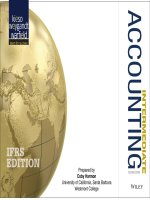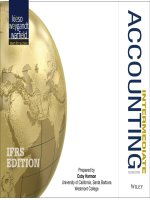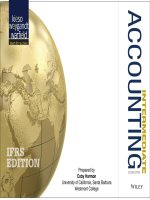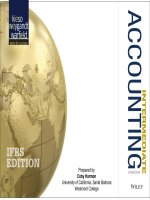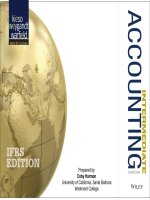Lecture Intermediate accounting (13th edition) Chapter 16 Kieso Weygandt, Warfield
Bạn đang xem bản rút gọn của tài liệu. Xem và tải ngay bản đầy đủ của tài liệu tại đây (3.6 MB, 96 trang )
Chapter
16-1
CHAPTER
16
DILUTIVE SECURITIES AND
EARNINGS PER SHARE
Intermediate Accounting
13th Edition
Kieso, Weygandt, and Warfield
Chapter
16-2
Learning
Learning Objectives
Objectives
1.
Describe the accounting for the issuance, conversion, and
retirement of convertible securities.
2.
Explain the accounting for convertible preferred stock.
3.
Contrast the accounting for stock warrants and for stock
warrants issued with other securities.
4.
Describe the accounting for stock compensation plans under
generally accepted accounting principles.
5.
Discuss the controversy involving stock compensation plans.
6.
Compute earnings per share in a simple capital structure.
7.
Compute earnings per share in a complex capital structure.
Chapter
16-3
Dilutive
Dilutive Securities
Securities and
and Earnings
Earnings Per
Per Share
Share
Dilutive Securities and
Compensation Plans
Debt and equity
Convertible debt
Convertible preferred
stock
Stock warrants
Accounting for
compensation
Chapter
16-4
Computing Earnings Per
Share
Simple capital structure
Complex capital
structure
Debt
Debt and
and Equity
Equity
Should companies report these instruments
as a liability or equity.
Stock Options
Chapter
16-5
Convertible
Securities
Preferred Stock
Accounting
Accounting for
for Convertible
Convertible Debt
Debt
Bonds which can be converted into other corporate
securities are called convertible bonds.
Benefit of a Bond (guaranteed interest)
+
Privilege of Exchanging it for Stock
(at the holder’s option)
Chapter
16-6
LO 1 Describe the accounting for the issuance, conversion,
and retirement of convertible securities.
Accounting
Accounting for
for Convertible
Convertible Debt
Debt
Two main reasons corporations issue convertibles:
Desire to raise equity capital without giving
up more ownership control than necessary.
Obtain common stock financing at cheaper
rates.
Chapter
16-7
LO 1 Describe the accounting for the issuance, conversion,
and retirement of convertible securities.
Accounting
Accounting for
for Convertible
Convertible Debt
Debt
At Time of Issuance
Convertible bonds recorded as straight debt issue,
with any discount or premium amortized over the
term of the debt.
Chapter
16-8
LO 1 Describe the accounting for the issuance, conversion,
and retirement of convertible securities.
Accounting
Accounting for
for Convertible
Convertible Debt
Debt
BE16-1: KC Inc. issued $4,000,000 par value, 7%
convertible bonds at 99 for cash. If the bonds had not
included the conversion feature, they would have sold
for 95.
Journal entry at date of issuance:
Cash
3,960,000
Discount on bonds payable
Bonds payable
40,000
4,000,000
($5,000,000 x 99% = $4,950,000)
Chapter
16-9
LO 1 Describe the accounting for the issuance, conversion,
and retirement of convertible securities.
Accounting
Accounting for
for Convertible
Convertible Debt
Debt
At Time of Conversion
Companies use the book value method when
converting bonds.
When the debt holder converts the debt to equity,
the issuing company recognizes no gain or loss upon
conversion.
Chapter
16-10
LO 1 Describe the accounting for the issuance, conversion,
and retirement of convertible securities.
Accounting
Accounting for
for Convertible
Convertible Debt
Debt
BE16-2: Yuen Corp. has outstanding 2,000, $1,000 bonds, each
convertible into 50 shares of $10 par value common stock. The
bonds are converted on December 31, 2010, when the unamortized
discount is $30,000 and the market price of the stock is $21 per
share.
Journal entry at conversion:
Bonds payable
2,000,000
Discount on bonds payable
Common stock (2,000 x 50 x $10)
Additional paid-in capital
Chapter
16-11
30,000
1,000,000
970,000
LO 1 Describe the accounting for the issuance, conversion,
and retirement of convertible securities.
Accounting
Accounting for
for Convertible
Convertible Debt
Debt
Induced Conversion
Issuer wishes to encourage prompt conversion.
Issuer offers additional consideration, called a
“sweetener.”
Sweetener is an expense of the period.
Chapter
16-12
LO 1 Describe the accounting for the issuance, conversion,
and retirement of convertible securities.
Accounting
Accounting for
for Convertible
Convertible Debt
Debt
BE16-2: Yuen Corp. has outstanding 2,000, $1,000 bonds, each
convertible into 50 shares of $10 par value common stock.
Assume Yuen wanted to reduce its annual interest cost and
agreed to pay the bond holders $70,000 to convert.
Journal entry at conversion:
Bonds payable
2,000,000
Discount on bonds payable
30,000
Common stock (2,000 x 50 x $10)
1,000,000
Additional paid-in capital
Debt conversion expense
Cash
Chapter
16-13
970,000
70,000
70,000
LO 1 Describe the accounting for the issuance, conversion,
and retirement of convertible securities.
Accounting
Accounting for
for Convertible
Convertible Debt
Debt
Retirement of Convertible Debt
Recognized same as retiring debt that is not
convertible.
Difference between the acquisition price and
carrying amount should be reported as gain or
loss in the income statement.
Chapter
16-14
LO 1 Describe the accounting for the issuance, conversion,
and retirement of convertible securities.
Convertible
Convertible Preferred
Preferred Stock
Stock
Convertible preferred stock includes an option for
the holder to convert preferred shares into a fixed
number of common shares.
Convertible preferred stock is considered part of
stockholders’ equity.
No gain or loss recognized when converted.
Use book value method.
Chapter
16-15
LO 2 Explain the accounting for convertible preferred stock.
Convertible
Convertible Preferred
Preferred Stock
Stock
BE16-3: Gall Inc. issued 2,000 shares of $10 par value
common stock upon conversion of 1,000 shares of $50 par value
preferred stock. The preferred stock was originally issued at
$60 per share. The common stock is trading at $26 per share
at the time of conversion.
Journal entry to record conversion:
Preferred stock
50,000
Paid-in capital – Preferred stock
10,000
Chapter
16-16
Common stock (2,000 x $10 par)
20,000
Paid-in capital – Common stock
40,000
LO 2 Explain the accounting for convertible preferred stock.
Stock
Stock Warrants
Warrants
Certificates entitling the holder to acquire
shares of stock at a certain price within a
stated period.
Normally arise:
Chapter
16-17
1.To
make a security more attractive
2.As
evidence of preemptive right
3.As
compensation to employees
LO 3 Contrast the accounting for stock warrants and for
stock warrants issued with other securities.
Stock
Stock Warrants
Warrants
Issued with Other Securities
Detachable Stock Warrants:
Proceeds allocated between the two securities.
Allocation based on fair market values.
Two methods of allocation:
(1) the proportional method and
(2) the incremental method
Chapter
16-18
LO 3 Contrast the accounting for stock warrants and for
stock warrants issued with other securities.
Stock
Stock Warrants
Warrants
Proportional Method
Determine:
1. value of the bonds without the warrants, and
2. value of the warrants.
The proportional method allocates the proceeds using
the proportion of the two amounts, based on fair
values.
Chapter
16-19
LO 3 Contrast the accounting for stock warrants and for
stock warrants issued with other securities.
Stock
Stock Warrants
Warrants
BE16-4: Margolf Corp. issued 2,000, $1,000 bonds at 101.
Each bond was issued with one detachable stock warrant.
After issuance, the bonds were selling in the market at 98,
and the warrants had a market value of $40. Use the
proportional method to record the issuance of the bonds and
warrants.
Chapter
16-20
LO 3
Stock
Stock Warrants
Warrants
BE16-4: Margolf Corp. issued 2,000, $1,000 bonds at 101.
Each bond was issued with one detachable stock warrant.
After issuance, the bonds were selling in the market at 98,
and the warrants had a market value of $40. Use the
proportional method to record the issuance of the bonds and
warrants.
Cash
2,020,000
Discount on bonds payable
Bonds payable
2,000,000
Paid-in capital – Stock warrants
Chapter
16-21
59,216
79,216
LO 3 Contrast the accounting for stock warrants and for
stock warrants issued with other securities.
Stock
Stock Warrants
Warrants
Incremental Method
Where a company cannot determine the fair value of
either the warrants or the bonds.
Use the security for which fair value can
determined.
Allocate the remainder of the purchase price to
the security for which it does not know fair value.
Chapter
16-22
LO 3 Contrast the accounting for stock warrants and for
stock warrants issued with other securities.
Stock
Stock Warrants
Warrants
BE16-5: McCarthy Inc. issued 2,000, $1,000 bonds at 101. Each
bond was issued with one detachable stock warrant. After
issuance, the bonds were selling in the market at 98. The market
price of the warrants, without the bonds, cannot be determined.
Use the incremental method to record the issuance of the bonds
and warrants.
Chapter
16-23
LO 3 Contrast the accounting for stock warrants and for
stock warrants issued with other securities.
Stock
Stock Warrants
Warrants
BE16-5: McCarthy Inc. issued 2,000, $1,000 bonds at 101. Each
bond was issued with one detachable stock warrant. After
issuance, the bonds were selling in the market at 98. The market
price of the warrants, without the bonds, cannot be determined.
Use the incremental method to record the issuance of the bonds
and warrants.
Cash
2,020,000
Discount on bonds payable
Bonds payable
2,000,000
Paid-in capital – Stock warrants
Chapter
16-24
40,000
60,000
LO 3 Contrast the accounting for stock warrants and for
stock warrants issued with other securities.
Stock
Stock Warrants
Warrants
Conceptual Questions
Detachable warrants involves
two securities,
a debt security,
a warrant to purchase common stock.
Nondetachable warrants
no allocation of proceeds between the bonds and the
warrants,
companies record the entire proceeds as debt.
Chapter
16-25
LO 3 Contrast the accounting for stock warrants and for
stock warrants issued with other securities.




